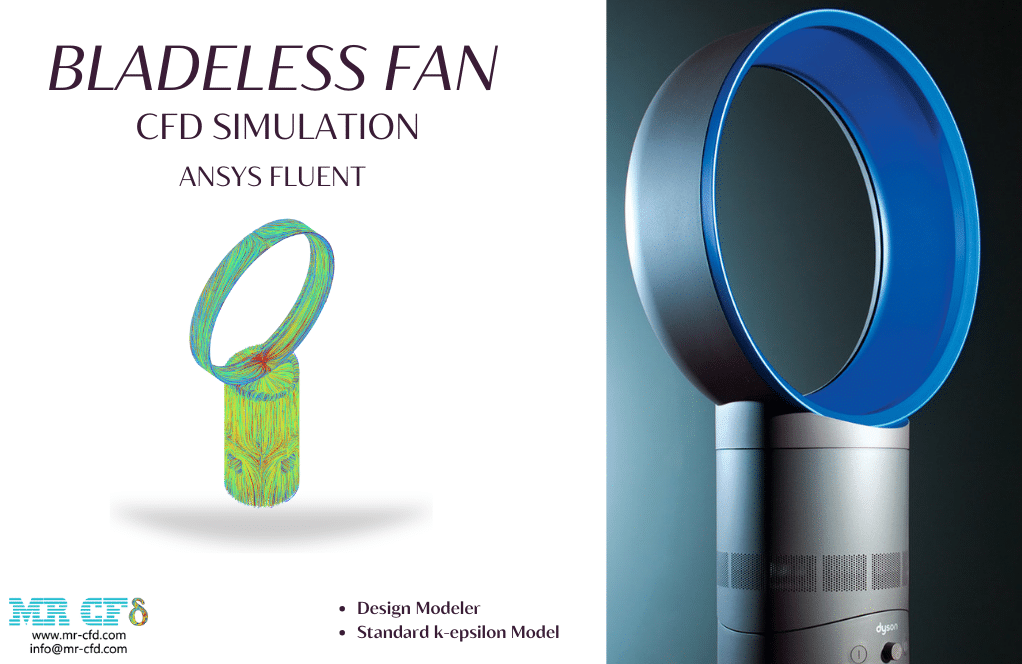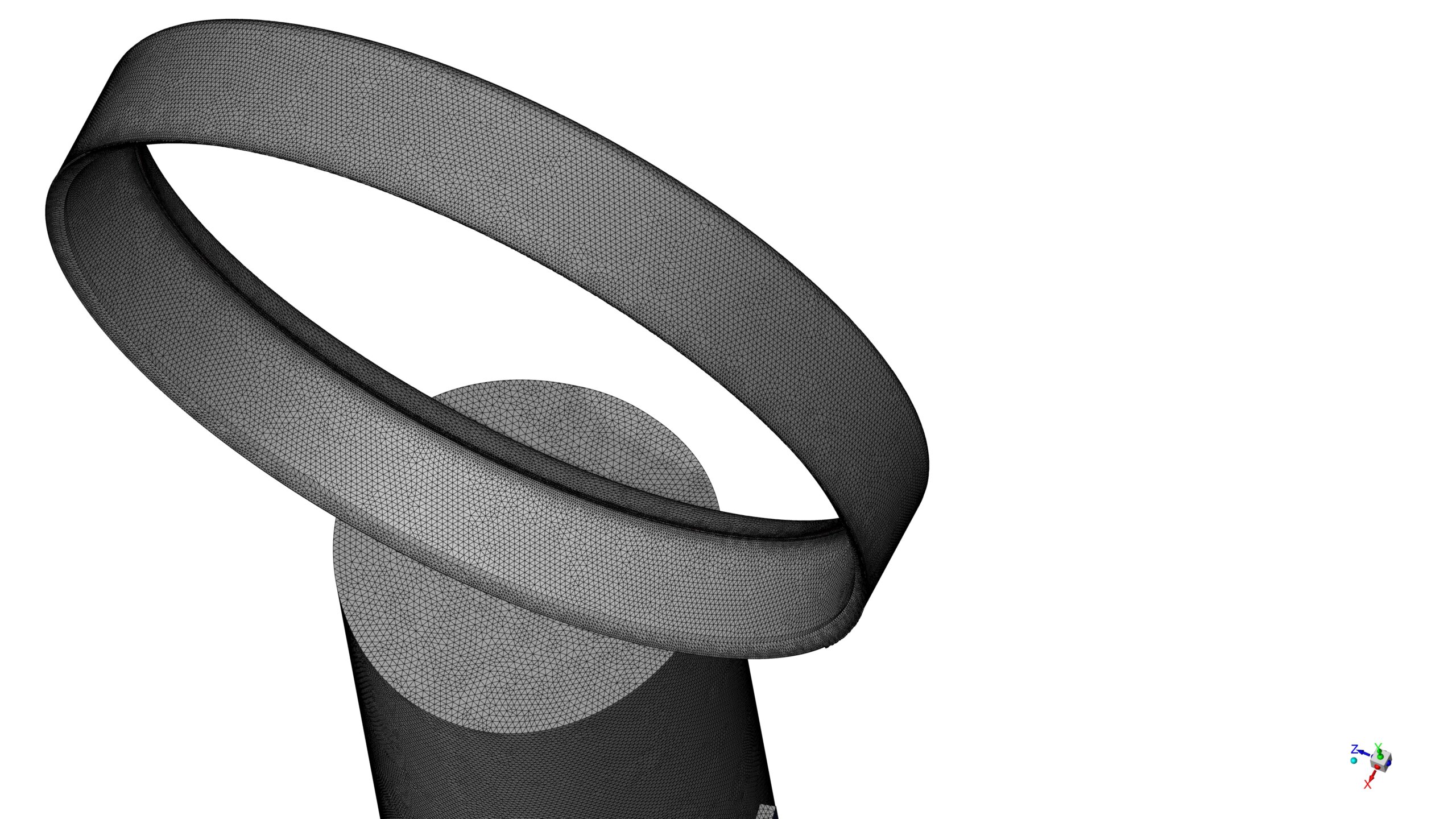Bladeless Fan CFD Simulation, ANSYS Fluent
$100.00 $50.00 Student Discount
- In this project, we have simulated performance of a Bladeless Fan using ANSYS Fluent software.
- Three-dimensional modeling was done using Design Modeler software.
- The meshing of the model has been done using ANSYS Meshing software and the element number equals 1,927,707.
- The standard k-epsilon model is used to simulate the turbulence of the flow.
To Order Your Project or benefit from a CFD consultation, contact our experts via email (info@mr-cfd.com), online support tab, or WhatsApp at +44 7443 197273.
There are some Free Products to check our service quality.
If you want the training video in another language instead of English, ask it via info@mr-cfd.com after you buy the product.
Description
Description
Unlike conventional fans, the bladeless fan does not produce airflow using moving blades. Instead, it draws air in and amplifies it using fluid dynamics principles and air-multiplier technology. The bladeless fan has several benefits over conventional fans; for instance, It is safer since no moving parts are exposed, particularly in homes with kids and dogs. It is more energy efficient than a conventional fan because it doesn’t require a motor to revolve the blades.
Here is a step-by-step explanation of how a bladeless fan operates. (Note that the explanation is in our simulation design, size, and dimension.)
Air Intake: Four square inlets, each with a side of 21mm, are located in the fan’s base, a cylinder with a diameter of 0.2 meters. These inlets draw The air around them into the fan’s base.
Air Amplification: The air drawn in is forced into the fan’s 0.52 meter-diameter cyclone section. The air is channeled through a ramp with the shape of an airfoil, which causes the air to spiral as it travels and picks up speed. On a flat surface, the air rushes along the airfoil without resistance, but as it crosses over the top, it generates a region of negative pressure, which causes the air to speed up and produce the airlift. A negative pressure region draws in more air and implies it 16 times. Eventually, it achieves completely safe, low-velocity, smooth airflow without blades.
Air Ejection: The high-speed air is discharged through a tiny slit in the fan’s top circular loop. Compared to the choppy air created by traditional fans, this results in a smooth, continuous stream of cooling air.
We modeled the geometry in the design modeler. Then, we meshed the model with ANSYS Meshing software with 1,927,707 cells.
Methodology
This project uses ANSYS Fluent software to simulate airflow behavior in a bladeless fan. Based on the inlet air flow rate (0.01 m^3/s), the inlet velocity is 5.67m/s.The standard k-epsilon model is used to simulate the turbulence of the flow. Fully turbulent flows are present in the bladeless fan, particularly in the cyclone portion. The k-epsilon model is a suitable fit for this application because it is known to give reasonably accurate predictions in totally turbulent flows.
Conclusion
Simulating the product in ANSYS Fluent resulted in obtaining some contours, vectors, and Pathlines, such as velocity pathlines, which showed how air finds its way to the cyclone flowing over the airflow and pressure and velocity contours presented over the considered planes to show the low-pressure area and velocity distribution.


















Herman Metz –
I’m fascinated by the technology behind bladeless fans and the simulation approach MR CFD uses. The detail in your explanation really helped me visualize the air movement within the fan!
MR CFD Support –
Thank you for your kind words! We’re delighted to hear that our simulation approach has provided you with a clear understanding of the bladeless fan technology. It’s always our goal to give comprehensive and detailed explanations to help our users visualize and grasp the concepts. Let us know if you have any further questions or interest in our CFD products!
Miss Gail Brakus PhD –
I learned so much from your Bladeless Fan CFD Simulation training material! I’m impressed with the clear step-by-step process and detailed explanation of the airflow amplification. The visualization of the flow through the fan was particularly interesting. Thanks for a great learning experience!
MR CFD Support –
We are delighted to hear that you found our Bladeless Fan CFD Simulation material helpful and informative! Visualizing the flow is indeed a crucial aspect of understanding fluid dynamics in such simulations. Thanks for taking the time to leave us a positive review. We’re always here to provide you with the best learning experience.
Nichole Strosin –
Just finished my study session on the Bladeless Fan CFD simulation course and I’m thoroughly impressed! The blend of theory and practical application was truly enlightening. Seeing how air-multiplier technology works in a simulation was fascinating, and being able to understand the science behind bladeless fans has given me a whole new appreciation for them. Top marks to the MR CFD Company for creating such an engaging and informative product. The visual aids were superb, and the detailed analysis helped me grasp the concepts with ease.
MR CFD Support –
Thank you for taking the time to share your positive experience! It’s really heartening to see our Bladeless Fan CFD Simulation course made such a vivid impression on you. We’re delighted that the material was enlightening and that you found the visual aids and analyses helpful for understanding the principles behind bladeless fans. We’d love to continue contributing to your learning journey, so don’t hesitate to reach out for more educational content!
Cortney VonRueden –
I’m impressed by how the bladeless fan efficiently amplifies and ejects the air without common fan blades. The simulation seems extremely thorough and showcases ANSYS Fluent’s capabilities well. Great job on presenting complex fluid dynamics in such an understandable format.
MR CFD Support –
Thank you for your kind words! We are delighted to hear that our Bladeless Fan CFD Simulation could impress you and that the explanation helped in understanding the fluid dynamics concepts leveraged in bladeless fans. If you have any more questions or need further information, feel free to reach out.
Aracely Farrell –
The visualization of airflow pathlines in the simulation seems fascinating!
MR CFD Support –
Thank you very much for your compliment! We’re glad you’re fascinated by the visualization and presentation of airflow pathlines in the bladeless fan simulation. It’s always rewarding to know that our simulation results are appreciated and useful to our customers. If you have any further questions or need assistance with other simulations, please feel free to reach out.
Jamie Ebert –
The Bladeless Fan simulation sounds impressive. It really seems to capture the intricacies of air movement through the device. Great job on explaining how the fan operates and how the simulation visually demonstrates the airflow!
MR CFD Support –
Thank you for your positive feedback! We are thrilled to hear that you found the Bladeless Fan CFD Simulation comprehensive and the explanation clear. It’s fantastic to know that our efforts to visually demonstrate the fluid dynamics within the fan through our simulation were successful. If you’re interested in learning more or discussing further simulations, please let us know – we’re here to help!
Justice Ritchie –
I’m thrilled with the bladeless fan CFD simulation! It’s educational to see how it amplifies the air using fluid dynamics and air-multiplier technology without the need for blades; plus, it’s great for safety and energy efficiency. The comprehensive step-by-step explanation really showcases the ingenuity behind this design!
MR CFD Support –
We’re so happy to hear that you find the bladeless fan CFD simulation informative and intriguing! It’s always rewarding to see our customers appreciate the detailed explanations of the innovative technology behind modern designs. Thank you for your positive feedback!
Zella Davis –
I absolutely loved the demo showing airflow in the bladeless fan! Seeing how the simulation perfectly captured the air dynamics gave me a real appreciation for the technology behind these fans. Keep up the great work!
MR CFD Support –
Thank you so much for your kind words! We’re thrilled to hear that our demonstration was able to convey the intricate airflow mechanics of the bladeless fan. Your feedback is greatly appreciated, and we hope our other products will impress you just as much!
Prof. Loy Effertz DDS –
The smooth airflow produced by the bladeless fan really makes it stand out from traditional fans. Good to know that safety is greatly improved without the blades. The increased energy efficiency is also a welcome feature in today’s eco-conscious world.
MR CFD Support –
Thank you for taking the time to share your positive feedback on our bladeless fan CFD simulation. We’re pleased to hear that you appreciate the innovative design and the benefits it brings. If you have any questions or need further information about our simulations, please don’t hesitate to ask.
Isobel Gorczany –
I’m thoroughly impressed with how the negative pressure effect is utilized in the bladeless fan simulation to amplify air movement smoothly!
MR CFD Support –
Thank you for sharing your positive impressions! We’re glad to hear that the bladeless fan simulation met your expectations and provided clear insights into the sophisticated airflow dynamics of this innovative device. If you have any more questions or need further assistance, feel free to reach out.
Eladio Medhurst PhD –
I’m blown away by the level of detail in the simulation! The use of air-multiplier technology for this bladeless fan design is fascinating. The entire explanation of how the fan works and its efficiency translated into the CFD domain really helps visualize the air dynamics. The comprehensive contours and vectors must give an excellent understanding of airflow behavior. This proves extremely helpful for anyone interested in the practical applications of fluid dynamics or product design improvements. Well done on a clear and informative simulation procedure.
MR CFD Support –
Thank you for your positive feedback! We’re thrilled that you found our detailed simulation and explanation of the bladeless fan technology to be informative and helpful. Your appreciation motivates us to continue providing high-quality simulations that not only explain the concepts but also offer valuable insights for product design and engineering. Should you have any more inquiries or need further information regarding our simulation products, please feel free to reach out.
Paxton Ziemann –
I’m amazed at the precision of this CFD simulation for a bladeless fan! It truly exhibits the capabilities of ANSYS Fluent in offering insights into the air amplification and smooth air flow patterns. It’s particularly interesting how negative pressure plays a significant role in amplifying the airflow without relying on blades. This is brilliant work that highlights the benefits of bladeless fan technology through a detailed simulation – unequivocally a valuable resource for anyone in the field of fluid dynamics or product design.
MR CFD Support –
We’re truly grateful for your positive feedback! It’s rewarding to know that our meticulous efforts to simulate the bladeless fan’s behavior in ANSYS Fluent have provided valuable insights and have been well received. If you have any further interests or queries in the realm of CFD simulations, please do not hesitate to reach out. Thank you again for your thoughtful compliments!